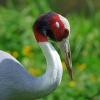Sexes alike. Whitish plumage sullied with grey-brown; pink on lower back, rump and flanks; whitetipped brown crest on back of head; black primaries and
dark brown secondaries distinctive in flight; flesh coloured gular pouch has a bluish-purple wash; at close range the blue spots on upper mandible and on gular pouch confirm identity of species. Purely aquatic; seen singly as well as in large gatherings, driving the fish into shallow waters before scooping up the prey in the gular pouches.
- Browse
- Gallery
- Checklists
- Topography
- Glossary
- Bibliography
- Feedback
- About Us




